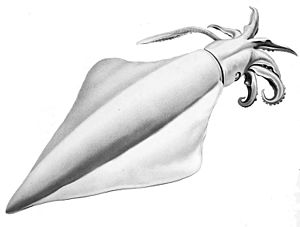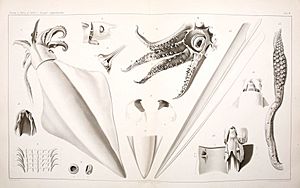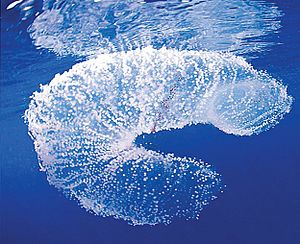Diamond squid facts for kids
Quick facts for kids Diamond squid |
|
|---|---|
 |
|
| Conservation status | |
| Scientific classification | |
| Synonyms | |
|
The Thysanoteuthis rhombus, also known as the diamond squid, is a large type of squid. You can find it all over the world in warm, tropical, and subtropical waters. It gets its name because its fins run along its body (called the mantle) and look like a diamond shape.
These squids grow very quickly and usually live for about one year. The diamond squid is special because it's the only known cephalopod (a group that includes squids, octopuses, and cuttlefish) that stays with one partner for life. Diamond squids eat fish and other small cephalopods. People also fish for them in Japan, especially in the Sea of Japan and around Okinawa.
Contents
What Does the Diamond Squid Look Like?
The diamond squid has arms with two rows of suckers. Its longer tentacles (used for catching prey) have four rows of suckers. This squid does not have special light-producing organs called photophores.
Its fins run the entire length of its body, or "mantle," giving it a diamond shape. These squids can grow quite large, up to 100 centimeters (about 3.3 feet) long. They can weigh as much as 30 kilograms (about 66 pounds), but they usually weigh around 20 kilograms (44 pounds).
The diamond squid is not a very fast swimmer. It moves slowly using its triangular fins. However, it can make strong pushes with its mantle to quickly escape from predators. These squids live for about one year. Males become adults when their mantle is 400 to 550 mm long (around 170 to 200 days old). Females mature when their mantle is 550 to 650 mm long (around 230 to 250 days old).
How Does the Diamond Squid Behave?
Diamond squids do not live in very dense groups. This low population density has led to their unique behavior: they are monogamous. This means a male and female squid of the same size stay together from when they are young until they die.
These squids hunt for food during the day in deep water. At night, they move to shallower water to feed. Diamond squids are often seen in pairs. However, sometimes groups of up to 20 squids have been spotted.
Diamond squids usually live in the open ocean in tropical and subtropical areas. They prefer water temperatures above 20 °C (68 °F). If the water temperature drops below 15 °C (59 °F) in shallow areas (0–100 meters deep), the diamond squid can become very inactive or even die.
What Does the Diamond Squid Eat?
Young diamond squids (juveniles) eat small crustaceans, other small cephalopods, and fish. Adult diamond squids mostly eat slow-moving fish. They find these fish at depths of 400 to 650 meters (about 1,300 to 2,100 feet).
Who Eats the Diamond Squid?
Many different animals hunt and eat diamond squids. These predators include other types of squids (like ommastrephid squids), dolphin fish, lancet fish, tuna, swordfish, and sharks. Mammals like dolphins, rough-toothed dolphins, false killer whales, and sperm whales also prey on them.
Diamond Squid Life Cycle and Reproduction
Male and female diamond squids form pairs when they are still young, with a mantle length less than 100 mm. They stay together for life. When they mate, the male and female face each other. The male uses a special arm called a hectocotylus to attach to the female's mouth area. This is how he transfers his sperm packets (spermatophores) to her.
In tropical waters, spawning (laying eggs) happens all year round and lasts for 2–3 months. In cooler areas, spawning usually happens in summer or early autumn when ocean currents are warmer. Diamond squids lay eggs multiple times in a row.
The female squid produces a gel-like substance from her glands. This substance swells in the water and she shapes it into a cylinder. Then, the female's glands form two sticky threads, each with a row of eggs. These threads join together into a single cord with a double row of eggs inside her body. The fertilized egg cord then comes out into the water and is wound onto the gel cylinder. A female can produce 8 to 12 of these egg masses if she is healthy.
Why Are Diamond Squids Important to People?
Diamond squids are becoming more important for fishing, especially in southern and central Japan. People like their firm and tasty meat. The main fishing areas are the Sea of Japan, Okinawa Prefecture, and Kagoshima Prefecture. About 90% of the diamond squids caught come from the Sea of Japan and Okinawa.
In the Sea of Japan, fishing happens from July to February. In Okinawa, it's mainly from November to April. Fishermen in the Sea of Japan use special trap nets and a type of fishing gear called "taru-nagashi." In Okinawa, they use "Hata-nagashi."
"Taru-nagashi" uses a long line with weights, lures, and hooks. A special buoy floats on the surface. When a squid gets hooked, the buoy stands up to tell the fisherman. The squid is then pulled up by hand or with a winch. "Hata-nagashi" is similar but adapted for Okinawa's ocean conditions. It has more lures on a longer line, attached to several buoys and a flag. This gear has helped fishermen catch more diamond squids.
Images for kids
See also
 In Spanish: Thysanoteuthis rhombus para niños
In Spanish: Thysanoteuthis rhombus para niños






